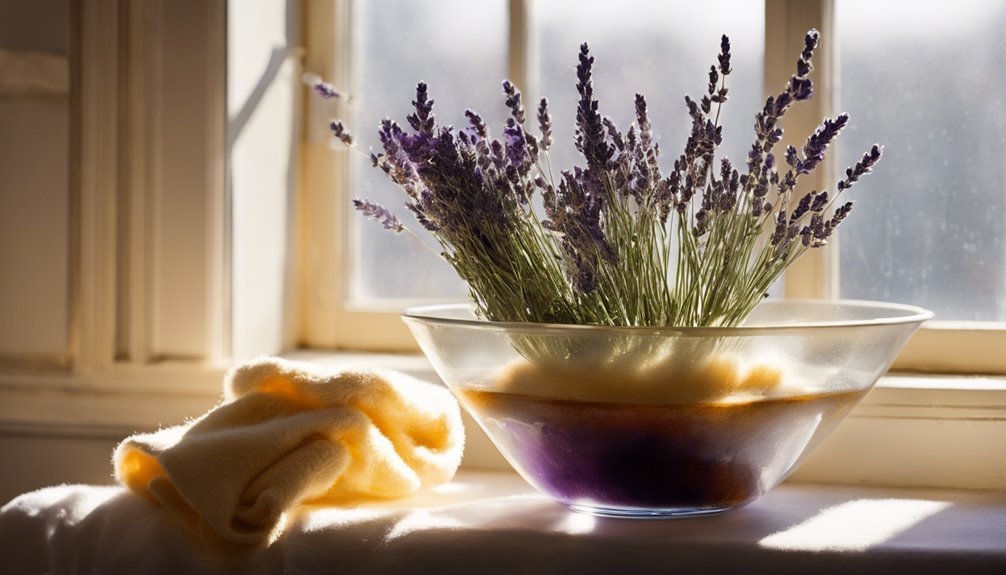How to Soften Scratchy Wool Socks Without Ruining Them
Have you ever noticed how your favorite wool socks, while perfect for keeping your feet warm, can sometimes feel as scratchy as a wooly mammoth's back? If this sounds familiar, you're not alone.
Wool socks are a staple in many wardrobes, especially during colder months, but their comfort can be compromised if they become stiff and scratchy.
To soften those scratchy wool socks without ruining them, start by giving them a good clean and turning them inside out. You can use a vinegar-water solution to help break down the stiff fibers or try a baking soda soak to neutralize any residues that may be causing the discomfort.
Another method is to dilute some hair conditioner in warm water for added softness. When washing, use a gentle, wool-safe detergent, rinse thoroughly, and then air-dry them flat or opt for a low-heat tumble cycle.
These techniques will help maintain the softness and durability of your wool socks.
Understanding Wool and Its Properties

Although wool is renowned for its warmth and durability, understanding its properties is essential for proper care and maintenance. Wool characteristics, such as its natural crimp and elasticity, provide excellent insulation and resilience. This fiber's hydrophilic nature allows it to absorb moisture without feeling wet, but it also means it requires specific fabric care to preserve these qualities. When caring for wool, remember that its protein structure is sensitive to heat and agitation. Use lukewarm water and gentle agitation to prevent felting. Avoid harsh detergents; opt for pH-neutral solutions instead. By respecting these properties, you'll maintain the integrity and comfort of your wool garments. Embrace the freedom wool offers by keeping its unique traits in mind while ensuring its longevity and comfort.
Preparing Your Wool Socks for Softening
Before you begin the softening process, examine the care label on your wool socks to determine any specific manufacturer guidelines that could impact treatment methods. Next, verify that all loose debris and lint are meticulously removed to prevent interference with the softening agents. Utilize a fabric brush or gentle lint roller for this task, as this will optimize the absorption of softening solutions.
Check Care Instructions
When preparing to soften your wool socks, start by thoroughly checking the care instructions provided by the manufacturer, which are typically found on the label. This step is essential for effective wool care, as different fabric types require specific handling. Understanding these guidelines guarantees you won't compromise the integrity of the fibers while achieving that desired softness. Look for details such as:
- Temperature settings: Ideal washing and drying temperatures prevent shrinkage.
- Detergent type: Use wool-friendly detergents to maintain fabric quality.
- Bleach advisories: Avoid harsh chemicals that can damage fibers.
- Drying method: Air-dry or low-heat tumble to preserve elasticity.
- Fabric softener usage: Some wool types may react adversely.
Remove Loose Debris
After thoroughly reviewing the care instructions, it's important to prepare your wool socks by removing any loose debris. Start by turning the socks inside out, which facilitates effective debris removal. Gently shake each sock to dislodge particles like lint, dirt, or other residues that may have accumulated. For stubborn debris, use a soft-bristle brush, applying light pressure to avoid damaging the delicate fibers. Pay particular attention to the heel and toe areas, where debris often collects due to friction.
This meticulous approach not only guarantees thorough sock maintenance but also primes your socks for the softening process, enhancing their comfort and longevity. By prioritizing debris removal, you're taking a critical step toward liberating your wool socks from scratchiness without compromising their integrity.
Using Vinegar for a Natural Softening Solution

To naturally soften your wool socks, utilize vinegar's acetic acid, which breaks down tough fibers without damaging the wool. Start by preparing a solution with one part vinegar to three parts water, ensuring the acidity is ideal for fiber relaxation. Apply the solution by soaking the socks for 15 minutes, then rinse thoroughly to remove any residual acidity, leaving your socks soft and comfortable.
Vinegar's Softening Properties
Vinegar, a versatile household staple, offers an effective and natural solution for softening wool socks. Its acidic properties break down the bonds that cause wool fibers to feel rough, enhancing your wool care routine. The vinegar benefits extend beyond just softening, providing a gentle, chemical-free approach that respects both the fabric and your desire for freedom from harsh treatments.
Here's why vinegar is your go-to:
- pH balance: Adjusts wool fiber structure without damage.
- Antibacterial properties: Keeps socks fresh and odor-free.
- Eco-friendly: Reduces reliance on synthetic softeners.
- Cost-effective: A budget-friendly alternative to commercial products.
- Multifunctional: Beyond softening, it cleans and revitalizes.
Preparing Vinegar Solution
When preparing a vinegar solution to soften wool socks, precision in measurement guarantees ideal results. Begin by mixing one part distilled white vinegar with two parts lukewarm water. This dilution facilitates the vinegar benefits without overpowering or damaging the delicate fibers. Using a non-reactive container, preferably glass or plastic, keeps the solution stable. Embrace this natural softening method as an eco-friendly alternative, enhancing wool care while maintaining the fabric's integrity.
Vinegar's acetic acid gently relaxes the fibers, reducing scratchiness while preserving the natural lanolin. Its pH-balancing properties neutralize residues that cause stiffness. Verify the solution's temperature is just right to avoid shocking the fibers—too hot might shrink, too cold won't activate the process. This meticulous preparation empowers you to achieve softness without compromise.
Application and Rinsing
Having prepared your vinegar solution, the next step involves the careful application and rinsing process to guarantee ideal softness for your wool socks. Employ precise application techniques by fully submerging the socks in the vinegar mixture, ensuring complete saturation. Allow them to soak for 15-30 minutes, permitting the acetic acid to penetrate the fibers.
When rinsing, utilize these methods for best results:
- Use lukewarm water to prevent wool shrinkage.
- Gently squeeze excess liquid without twisting.
- Rinse repeatedly until the vinegar scent dissipates.
- Air-dry naturally rather than using a dryer, avoiding heat exposure.
- Inspect for softness and repeat if necessary.
The Benefits of a Baking Soda Soak

For those seeking to enhance the comfort of their wool socks, a baking soda soak offers a scientifically sound solution. This method leverages the alkaline nature of baking soda to neutralize acidic residues within the fibers, a common cause of itchiness. The baking soda benefits extend to softening the wool by gently relaxing the fibers without compromising their integrity.
To employ effective soaking techniques, dissolve a quarter cup of baking soda in a basin of lukewarm water. Submerge the socks, allowing them to soak for 15-30 minutes. This period guarantees thorough penetration, transforming scratchy textures into supple comfort. Rinse thoroughly with cool water to remove residual baking soda. Embrace the freedom of moving through your day with socks that feel as good as they look.
Leveraging the Power of Hair Conditioner
An effective method to enhance the softness of wool socks involves using hair conditioner, a common household product known for its fiber-softening properties. Start by diluting the conditioner in warm water to prevent residue buildup. Immerse your socks, guaranteeing even coverage. Allow them to soak, capitalizing on hair conditioner benefits to penetrate fibers.
Key application techniques include:
- Dilution Ratio: Use about one tablespoon of conditioner per liter of water.
- Soaking Time: Let the socks sit for at least 30 minutes.
- Water Temperature: Maintain warmth for peak absorption.
- Gentle Handling: Avoid vigorous movements that could distort the fabric.
- Rinse Thoroughly: Confirm all traces of conditioner are removed to maintain breathability.
Harnessing these techniques, you'll liberate your feet with comfort and softness.
Gentle Washing Techniques to Prevent Scratchiness
While the benefits of hair conditioner can greatly enhance wool softness, effective washing techniques also play an essential role in preventing scratchiness. Start by selecting gentle detergents specifically formulated for wool. These detergents maintain the integrity of the wool fibers, ensuring they remain soft. Mix the detergent in lukewarm water to prevent fiber contraction and agitation. Immerse your socks, gently agitating them without excessive rubbing. This process avoids fiber entanglement, which leads to scratchiness.
Consider adding a fabric softener designed for wool during the rinse cycle. It aids in smoothing the fibers further, enhancing softness. Rinse thoroughly to remove all detergent residues, as they can stiffen fibers. Handle your wool socks with care throughout, and you'll enjoy the freedom of softer, more comfortable wear.
Drying Methods to Maintain Softness
To maintain the softness of your wool socks, proper drying techniques are vital. Air drying is your best friend; it minimizes fiber agitation and retains elasticity. Lay socks flat on a clean, dry surface, away from direct sunlight to prevent UV degradation. If you opt for machine drying, select a low-heat setting to avoid thermal shock which can harden fibers. Employ these approaches for peak results:
- Air Circulation: Use a fan to expedite air drying without direct heat.
- Gentle Squeeze: After washing, gently squeeze—don't wring—to remove excess water.
- Mesh Drying Rack: Supports even drying without stretching the fabric.
- Cool Tumble: If machine drying, use a delicate cycle.
- Avoid Overloading: Prevents uneven drying and maintains softness.
These methods guarantee your socks remain luxuriously soft without compromising their integrity.
Frequently Asked Questions
Can Scratchy Wool Socks Cause Skin Irritation or Allergies?
You might experience skin irritation or wool allergies from scratchy wool socks. Wool fibers can sometimes trigger allergic reactions or exacerbate sensitive skin, leading to discomfort. Opt for high-quality, treated wool to enjoy comfort without constraints.
How Often Should Wool Socks Be Softened?
To maintain comfort, it's recommended you soften wool socks every 5-6 washes. This frequency guarantees ideal sock care, preserving fibers' integrity while enhancing comfort. Consider using a gentle conditioner for best results, granting you freedom from discomfort.
Are There Alternative Natural Softening Methods for Wool Socks?
You can soften your wool socks naturally with a vinegar rinse, which neutralizes detergent residues, or use hair conditioner. Simply soak them in a mix of water and conditioner, then rinse thoroughly for a softer feel.
Can I Soften Wool Socks That Are a Wool Blend?
Softening wool blend socks involves exploring wool blend benefits and applying softening techniques. Imagine fibers relaxing, textures smoothing. Gently hand wash with mild detergent, rinse with vinegar solution, air dry flat. Your socks will feel luxuriously soft.
How Long Does the Softening Effect Last on Wool Socks?
The softening duration of wool socks varies based on wool sock care practices. Regular maintenance, like proper washing and conditioning, can prolong softness. Typically, expect a few wears before needing another treatment to maintain ideal comfort.







